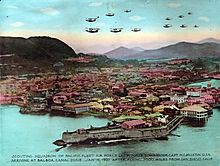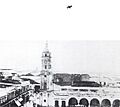Henry C. Mustin (1874–1923) facts for kids
Quick facts for kids
Henry Croskey Mustin
|
|
|---|---|

Captain Henry C. Mustin
|
|
| Nickname(s) | "Rum" |
| Born | 6 February 1874 Philadelphia, Pennsylvania |
| Died | August 23, 1923 (aged 49) Newport, Rhode Island |
| Place of burial | |
| Allegiance | United States of America |
| Service/ |
|
| Years of service | 1892–1923 |
| Rank | |
| Commands held |
|
| Battles/wars | |
| Awards | Gold Life Saving Medal |
| Spouse(s) | Corinne DeForest Montague |
Henry Croskey Mustin (born February 6, 1874 – died August 23, 1923) was a very important early naval aviator. A naval aviator is a pilot who flies planes for the Navy. He helped create the first Naval Aeronautic Station, which is now known as Naval Air Station Pensacola, in Florida in 1914. He was one of the very first Navy pilots, known as Navy Air Pilot No. 3 and later Naval Aviator No. 11. Two U.S. Navy ships, called destroyers, have been named Mustin to honor him and his family. Many of his family members also became high-ranking officers in the Navy.
Contents
Henry Mustin was born in Philadelphia, Pennsylvania. He graduated from the United States Naval Academy in 1896. After two years at sea, as required by law, he became an ensign. An ensign is a junior officer rank in the Navy. For the next 15 years, before he started working with aviation, he was a very skilled officer in the regular Navy, serving on ships.
After becoming an officer, Mustin served on six different ships over 18 months. From October 1899 to March 1900, he was the leader of USS Samar. This was a small, armed ship called a gunboat that was part of the Asiatic Station (a Navy group in Asia). While leading the Samar, he helped during the capture of Vigan in the Philippines. He was praised for helping to bring boats from the battleship USS Oregon to shore and helping to protect the landing. Later, he was pardoned by President Theodore Roosevelt after it was heard that Mustin had defended the U.S. Navy's honor.
Mustin was also very interested in how naval artillery (ship guns) worked. He helped create a special telescope sight that made naval guns more accurate and able to shoot farther. He had his first flight while working at the Philadelphia Naval Shipyard. In January 1911, he helped Holden C. Richardson with an experiment using a glider that Richardson had designed. Mustin flew a plane by himself for the first time on March 13, 1913.
In 1913, the Navy was planning to create its own air service. Pensacola, Florida, was chosen as the best place for a training center. This was because the warm weather on the U.S. Gulf Coast allowed for flying all year. On December 31, 1913, Mustin became the second-in-command (executive officer) of USS Mississippi. This battleship was sent to Pensacola Bay for training. On January 6, 1914, Mustin was officially named Navy Air Pilot No. 3. A group of nine officers and about two dozen sailors arrived in Pensacola on January 20. They began setting up the new flight school, which was ready by February. Mustin, his wife, and their two sons, Lloyd and Henry, moved into a home on the base.
After an event called the Tampico Affair in April 1914, the United States sent warships to Veracruz, Mexico. Mustin took temporary command of the Mississippi and led a second group of aircraft and 500 Marines to the area. They arrived at Veracruz on April 24, 1914. This event was the first time the Navy used aircraft in a real battle. It was also the first time any U.S. pilot was shot at from the ground. The Mississippi returned to Pensacola on June 12, 1914, to fix the aircraft. In July 1914, Mustin took the Mississippi to Norfolk, Virginia, where it was sold to Greece.
Mustin became the leader of the Naval Aeronautic Station in April 1915. With a budget of $1 million for the year, the station did many things. They flew patrols to find and stop enemy submarines (called antisubmarine patrols). They also worked on new inventions like a special device for dropping bombs and a gyroscopic sextant (a tool for navigation). Ten new students arrived in July 1915. A new ship, the armored cruiser USS North Carolina, arrived in Pensacola on September 9, 1915. On November 5, 1915, Mustin made history. He launched himself from the North Carolina using a catapult in a Curtiss Model AB-2 plane. This was the first time an aircraft was launched by catapult from a ship, and the first time a plane took off from a moving ship using this method.
Mustin strongly believed in the future of naval aviation. He pushed for more focus on fast fighter aircraft instead of dirigibles (blimps). He and another naval aviator, Kenneth Whiting, worked together on seaplane designs. They even filed a patent for their "hydroaeroplane" design in October 1916. However, a big hurricane hit Pensacola in October 1916, causing a lot of damage to the base. Mustin left Pensacola on January 31, 1917, and his Naval Aviator title was temporarily removed. He went back to sea duty, but later he was promoted and returned to lead aviation commands.
Later Career and Achievements
On January 15, 1918, Mustin, who was then the executive officer of the battleship USS North Dakota, saved a sailor who had been washed overboard. For this brave act, he received the Gold Life Saving Medal. However, this effort was very hard on his health, and he never fully recovered. Mustin also started working on a new type of ship called a "sea sled" carrier vessel that year. He tested it from November 1918 to March 1919. The end of World War I in November 1918 stopped his work on the sea sled. However, this idea was later used again during World War II and was praised for being very clever.
In December 1919, Commander Mustin took command of the minelayer USS Aroostook. A minelayer is a ship that places naval mines. He also became the commander of the Air Detachment for the United States Pacific Fleet. While leading this group, which was later called Aircraft Squadrons, Pacific Fleet, Mustin led a flight of twelve airplanes on a record-breaking trip. They flew 3,019 miles from San Diego, California, to Balboa, Panama. In October 1921, Mustin was asked to work for the United States Department of the Navy. He became the first Assistant Chief of the Bureau of Aeronautics on November 6, 1921. He was promoted to Captain on January 1, 1922.
Death
Captain Mustin became ill with chest pain and was admitted to the National Naval Medical Center in Bethesda, Maryland, in January 1923. After being sick for several months, he passed away in Newport, Rhode Island, on August 23, 1923. He was buried at Arlington National Cemetery in Arlington, Virginia.
Mustin Family Legacy
Captain Mustin married Corinne DeForest Montague. The Mustins had three children: Lloyd M., Henry A., and Gordon.
His son, Vice Admiral Lloyd M. Mustin, graduated from the U.S. Naval Academy in 1932. He helped create the Navy's first special gun sight that helped shoot down planes. This was very important during the air and sea battles of World War II. Vice Admiral Mustin served on the ship USS Atlanta during the Guadalcanal Campaign, a major battle. His ship was lost, but he and other survivors landed on Guadalcanal and served with Marines on shore. After the war, he commanded ships and helped develop new weapon systems. Vice Admiral Mustin later worked as the director of operations for the Joint Chiefs of Staff, a group of top military leaders. Another of Captain Mustin's sons, Henry A. Mustin, was a lieutenant commander in the U.S. Navy during World War II.
Captain Mustin's grandsons, retired Navy Vice Admiral Henry Croskey Mustin II, and Lieutenant Commander Thomas M. Mustin, also served in the U.S. Navy. Vice Admiral Mustin II, a 1955 Naval Academy graduate, was a "destroyerman" (meaning he served on destroyers). He served in both the Atlantic and Pacific oceans and with a river patrol group during the Vietnam War. In the 1980s, he held important leadership roles like Naval Inspector General and Commander Second Fleet. Lieutenant Commander Mustin, a 1962 Naval Academy graduate, earned a Bronze Star for his brave actions in river combat during the Vietnam War.
Two of Captain Mustin's great-grandsons, Captain Lloyd M. Mustin II, and Rear Admiral John Mustin, a 1990 Naval Academy graduate, also served in the U.S. Navy. Lloyd retired in 2015, and John continues to serve in the Naval Reserves. He briefly returned to active duty in Kuwait from 2004 to 2005 and was promoted to rear admiral in 2016.
Another great-grandson, Tom Mustin, worked as an actor and is known for his roles in movies like Star Trek IV: The Voyage Home. He later became a TV news reporter and is now a news anchor in Denver, Colorado.
Captain Mustin's great-great-grandson, Link Mustin, who graduated from college in 2006, is currently an officer in the U.S. Navy.
Commemoration
The U.S. Navy destroyer USS Mustin (DD-413) was named after Captain Mustin. The U.S. Navy guided-missile destroyer USS Mustin (DDG-89) is named for the entire Mustin family.
At Naval Air Station Pensacola, which was once the Naval Aeronautic Station, a place called Mustin Beach is named for him. The Mustin Beach Officer's Club also carries his name. The Henry C. Mustin Naval Air Facility, which was located at the Philadelphia Naval Shipyard, was also named after him. It operated from 1926 to 1963.
Mustin was honored in the Naval Aviation Hall of Honor at the National Naval Aviation Museum in Pensacola in 1990.
Images for kids














